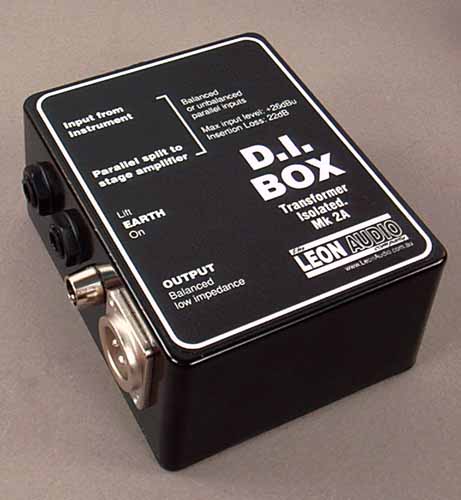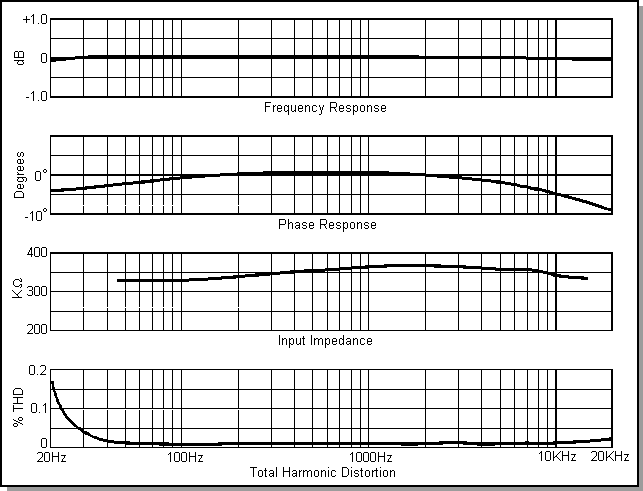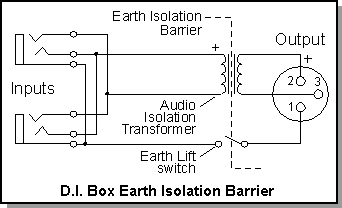
| | Home | Contact us | |
A Dual Channel passive DI is now available.
Same specs and size as the single channel DI below
| Passive D.I. Box |

| Description |
Suitable for the most demanding of situations in both live and recording applications.
A no-compromise audio isolation transformer designed by The Leon Audio Company provides very high sound quality and the maximum possible rejection of external electrical interference, such as dimmer buzz.
The transformer also provides excellent isolation of high common mode (earth) voltages, well above the level that an active D.I. box could handle without destruction. Optimised internal design of the isolation transformer provides earth isolation performance approaching the theoretical maximum. This translates into excellent performance when isolating input and output circuits.
An optimally balanced output, provided by the transformer, is ideal for driving long balanced cables, such as multicores. The output can also be connected to unbalanced circuits.
The fully floating balanced input and output are able to accept either 3 conductor balanced circuits or 2 conductor unbalanced circuits, providing an ideal unbalanced/balanced or balanced/unbalanced interface.
An input impedance several times higher than many commercial units ensures accurate reproduction of a musical instrument by providing minimal electrical loading on the source, which could otherwise result in degraded performance.
Effective screening against hum pickup from nearby transformers, such as those in power amplifiers, is provided by a MU metal shield which totally encloses the transformer.
High signal level handling ability means that no pad or attenuator switch
is required. A totally passive design means that no batteries or phantom
power required.
| Passive D.I. Box Specification |
| Frequency Response | 20Hz - 20kHz ±0.1dB |
| Phase Response | -10° at 10KHz |
| Nominal Input Impedance | Greater than 300K ohms |
| Recommended Load Impedance | 2000 ohms or greater |
| Maximum Input Level | +26dBu |
| Output Level | -22dBu (0dBu input) |
| Total Harmonic Distortion (T.H.D.) | <0.1% 30Hz - 20KHz up to +22dBu |
| Insertion Loss | 22dB |
| Power Supply | None required |
| Finish | Powder coated die cast aluminium |
| Weight | 440 grams net. |
| Dimensions | W 95mm H 120mm D 67mm |
| Response Plots |

| What's in a D.I. Box? |
D.I. Boxes are constructed using one of two common techniques.
- The first type uses electronic circuitry and are known as active D.I. Boxes. They require either Phantom Power or a battery supply.
- The second type uses an audio transformer and are known as either transformer or passive D.I. Boxes. They require no power supply.
![]() 1. Impedance Conversion.
1. Impedance Conversion.
![]() 2. Unbalanced to balanced conversion.
2. Unbalanced to balanced conversion.
![]() 3. Earth isolation.
3. Earth isolation.
![]() 1. Impedance Conversion.
1. Impedance Conversion.
The medium or high impedance of a signal source is converted to a low
impedance suitable for feeding down a long multicore to a mixing desk’s
microphone input. A low impedance enables long cable runs with very little
quality loss, with low susceptibility to external electrical interference
(hum and buzzes). A D.I. box provides a high input impedance for connection
to a signal source, and a low output impedance for connection to a microphone
input of a mixing desk.
![]() 2. Unbalanced To Balanced Conversion.
2. Unbalanced To Balanced Conversion.
The unbalanced (2 conductor) wiring of a signal source is converted
to the balanced (3 conductor) wiring of a mixing desk.. A balanced cable
provides good rejection of electrical interference. An unbalanced cable
does not. Active D.I. Boxes are potentially capable of providing excellent
unbalanced to balanced conversion, but due to cost restrictions, many are
poor performers in this area. Transformer D.I. Boxes provide excellent
unbalanced to balanced conversion.
![]() 3. Earth Isolation.
3. Earth Isolation.
A D.I. Box provides isolation between the earth wiring of a signal
source (e.g. musical instrument) and the sound system being connected together.
This prevents earth loops which cause hum and buzzes.
An earth loop occurs when a device, such as a keyboard, is connected to the mains earth via more than one path. The first path is via the instrument's own power cable to the mains earth. The second path is via the interconnecting audio cable to the sound system, then via the sound system's power cable to the main's earth. The resultant circulating earth current is amplified and is often heard as a hum or buzz. Active D.I. Boxes are usually very poor at providing good earth isolation between an instrument and a sound system because there is a direct electrical path between the instrument and the sound system. There is not isolating device such as a transformer, as there is in a passive D.I.
Earth Lift Switches.
D.I. boxes have an earth lift switch to allow the input and output
earths of the D.I. box to be disconnected, so that earth loops can be broken.
Disconnecting the signal (audio) earth is not a safety issue, as the Protective
Earths in all the mains cables are still connected and fully functional.

- If the instrument is connected to the mains earth, open the Earth Lift Switch.
- If there is no mains earth connected to the instrument, close the Earth Lift Switch.
| 2 Year Warranty |
The Passive D.I. Boxes are guaranteed for two years from date of original
purchase against defects in workmanship and materials.
If such malfunction occurs, the item will be repaired or replaced (at
our option) without charge for materials or labour if delivered prepaid
to THE LEON AUDIO COMPANY. Unit will
be returned prepaid. Warranty does not cover finish or malfunction due
to abuse or operation at other than specified conditions. Repairs by other
than THE LEON AUDIO COMPANY or authorised agents will void this guarantee
| Brochure |
| Download brochure for the Passive D.I. Box.
PDIB2a.pdf (120Kb) in Adobe Acrobat format |
| Home | To top | Contact us |
Copyright © 2024. The Leon Audio Company. All rights reserved.